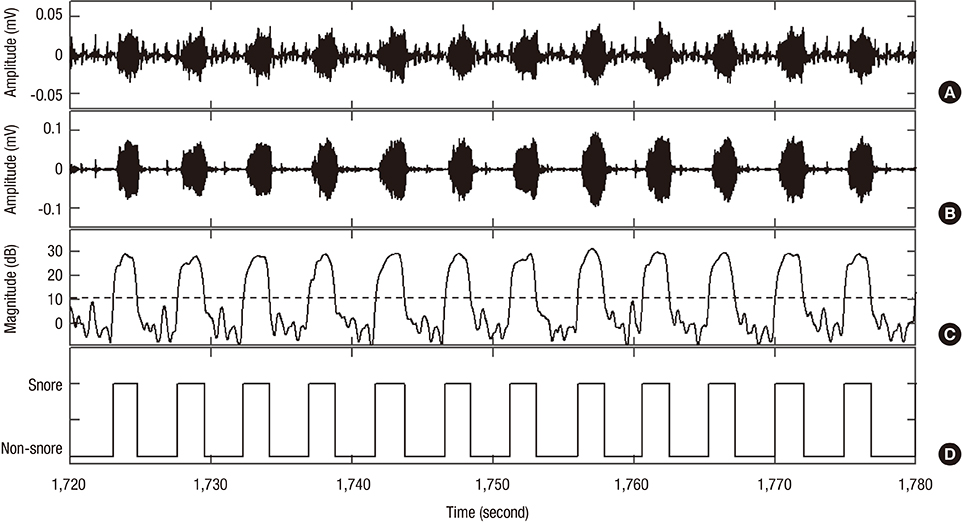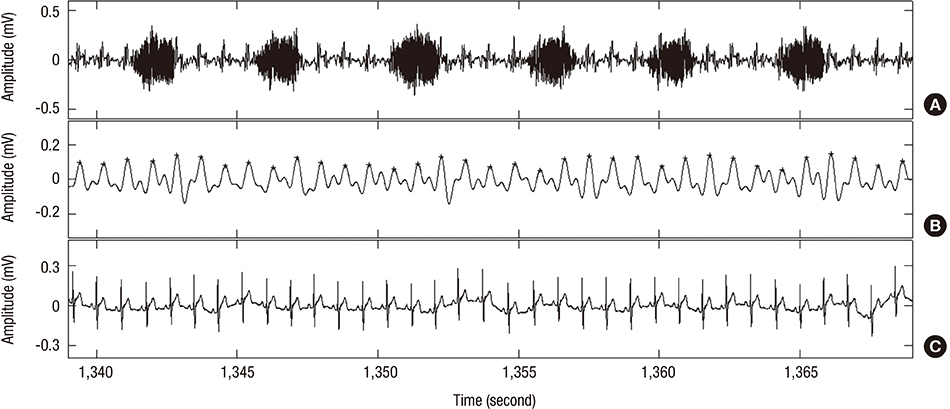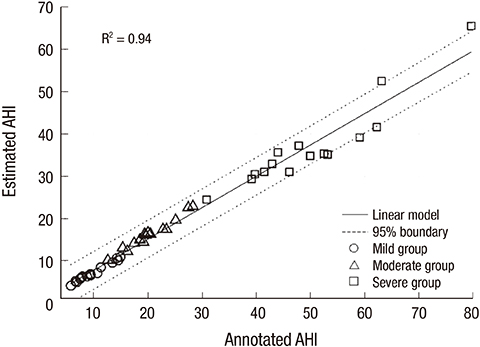J Korean Med Sci.
2017 Jun;32(6):893-899. 10.3346/jkms.2017.32.6.893.
Obstructive Sleep Apnea Screening Using a Piezo-Electric Sensor
- Affiliations
-
- 1Department of Biomedical Engineering, School of Health Science, Yonsei University, Wonju, Korea. lkj5809@yonsei.ac.kr
- KMID: 2377717
- DOI: http://doi.org/10.3346/jkms.2017.32.6.893
Abstract
- In this study, we propose a novel method for obstructive sleep apnea (OSA) detection using a piezo-electric sensor. OSA is a relatively common sleep disorder. However, more than 80% of OSA patients remain undiagnosed. We investigated the feasibility of OSA assessment using a single-channel physiological signal to simplify the OSA screening. We detected both snoring and heartbeat information by using a piezo-electric sensor, and snoring index (SI) and features based on pulse rate variability (PRV) analysis were extracted from the filtered piezo-electric sensor signal. A support vector machine (SVM) was used as a classifier to detect OSA events. The performance of the proposed method was evaluated on 45 patients from mild, moderate, and severe OSA groups. The method achieved a mean sensitivity, specificity, and accuracy of 72.5%, 74.2%, and 71.5%; 85.8%, 80.5%, and 80.0%; and 70.3%, 77.1%, and 71.9% for the mild, moderate, and severe groups, respectively. Finally, these results not only show the feasibility of OSA detection using a piezo-electric sensor, but also illustrate its usefulness for monitoring sleep and diagnosing OSA.
Keyword
MeSH Terms
Figure
Cited by 1 articles
-
Prediction of Obstructive Sleep Apnea Based on Respiratory Sounds Recorded Between Sleep Onset and Sleep Offset
Jeong-Whun Kim, Taehoon Kim, Jaeyoung Shin, Goun Choe, Hyun Jung Lim, Chae-Seo Rhee, Kyogu Lee, Sung-Woo Cho
Clin Exp Otorhinolaryngol. 2019;12(1):72-78. doi: 10.21053/ceo.2018.00388.
Reference
-
1. Iber C, Ancoli-Israel S, Chesson AL, Quan SF. The AASM Manual for the Scoring of Sleep and Associated Events: Rules, Terminology and Technical Specifications. Westchester, IL: American Academy of Sleep Medicine;2007.2. Vgontzas AN, Papanicolaou DA, Bixler EO, Hopper K, Lotsikas A, Lin HM, Kales A, Chrousos GP. Sleep apnea and daytime sleepiness and fatigue: relation to visceral obesity, insulin resistance, and hypercytokinemia. J Clin Endocrinol Metab. 2000; 85:1151–1158.3. Young T, Evans L, Finn L, Palta M. Estimation of the clinically diagnosed proportion of sleep apnea syndrome in middle-aged men and women. Sleep. 1997; 20:705–706.4. Barbé F, Pericás J, Muñoz A, Findley L, Antó JM, Agustí AG, de Lluc Joan M. Automobile accidents in patients with sleep apnea syndrome: an epidemiological and mechanistic study. Am J Respir Crit Care Med. 1998; 158:18–22.5. Pack AI, Gislason T. Obstructive sleep apnea and cardiovascular disease: a perspective and future directions. Prog Cardiovasc Dis. 2009; 51:434–451.6. Mendez MO, Corthout J, Van Huffel S, Matteucci M, Penzel T, Cerutti S, Bianchi AM. Automatic screening of obstructive sleep apnea from the ECG based on empirical mode decomposition and wavelet analysis. Physiol Meas. 2010; 31:273–289.7. Erman MK, Stewart D, Einhorn D, Gordon N, Casal E. Validation of the ApneaLink for the screening of sleep apnea: a novel and simple single-channel recording device. J Clin Sleep Med. 2007; 3:387–392.8. Lévy P, Pépin JL, Deschaux-Blanc C, Paramelle B, Brambilla C. Accuracy of oximetry for detection of respiratory disturbances in sleep apnea syndrome. Chest. 1996; 109:395–399.9. Karunajeewa AS, Abeyratne UR, Hukins C. Multi-feature snore sound analysis in obstructive sleep apnea-hypopnea syndrome. Physiol Meas. 2011; 32:83–97.10. Abeyratne UR, Wakwella AS, Hukins C. Pitch jump probability measures for the analysis of snoring sounds in apnea. Physiol Meas. 2005; 26:779–798.11. Roche F, Gaspoz JM, Court-Fortune I, Minini P, Pichot V, Duverney D, Costes F, Lacour JR, Barthélémy JC. Screening of obstructive sleep apnea syndrome by heart rate variability analysis. Circulation. 1999; 100:1411–1415.12. Sirohi J, Chopra I. Fundamental understanding of piezoelectric strain sensors. J Intell Mater Syst Struct. 2000; 11:246–257.13. Lee HK, Lee J, Kim H, Ha JY, Lee KJ. Snoring detection using a piezo snoring sensor based on hidden Markov models. Physiol Meas. 2013; 34:N41–N49.14. Dafna E, Tarasiuk A, Zigel Y. Automatic detection of whole night snoring events using non-contact microphone. PLoS One. 2013; 8:e84139.15. Ishida R, Yonezawa Y, Maki H, Ogawa H, Ninomiya I, Sada K, Hamada S, Hahn AW, Caldwell WM. A wearable, mobile phone-based respiration monitoring system for sleep apnea syndrome detection. Biomed Sci Instrum. 2005; 41:289–293.16. Bu N, Ueno N, Fukuda O. Monitoring of respiration and heartbeat during sleep using a flexible piezoelectric film sensor and empirical mode decomposition. Conf Proc IEEE Eng Med Biol Soc. 2007; 2007:1362–1366.17. Viera AJ, Garrett JM. Understanding interobserver agreement: the kappa statistic. Fam Med. 2005; 37:360–363.18. Solà-Soler J, Jané R, Fiz JA, Morera J. Automatic classification of subjects with and without sleep apnea through snoring analysis. Conf Proc IEEE Eng Med Biol Soc. 2007; 2007:6094–6097.19. Azarbarzin A, Moussavi ZM. Automatic and unsupervised snore sound extraction from respiratory sound signals. IEEE Trans Biomed Eng. 2011; 58:1156–1162.20. Nakano H, Hayashi M, Ohshima E, Nishikata N, Shinohara T. Validation of a new system of tracheal sound analysis for the diagnosis of sleep apnea-hypopnea syndrome. Sleep. 2004; 27:951–957.
- Full Text Links
- Actions
-
Cited
- CITED
-
- Close
- Share
- Similar articles
-
- Pediatric sleep questionnaires for screening of obstructive sleep apnea syndrome
- Application of Clinical Features and the Degree of Oxygen Desaturation as a Screening Test for the Obstructive Sleep Apnea Syndrome
- A Case of Huge Lingual Tonsillar Hypertrophy Causing Obstructive Sleep Apnea in Adult
- Pathogenesis of Obstructive Sleep Apnea
- Effects of Menopause on Obstructive Sleep Apnea





